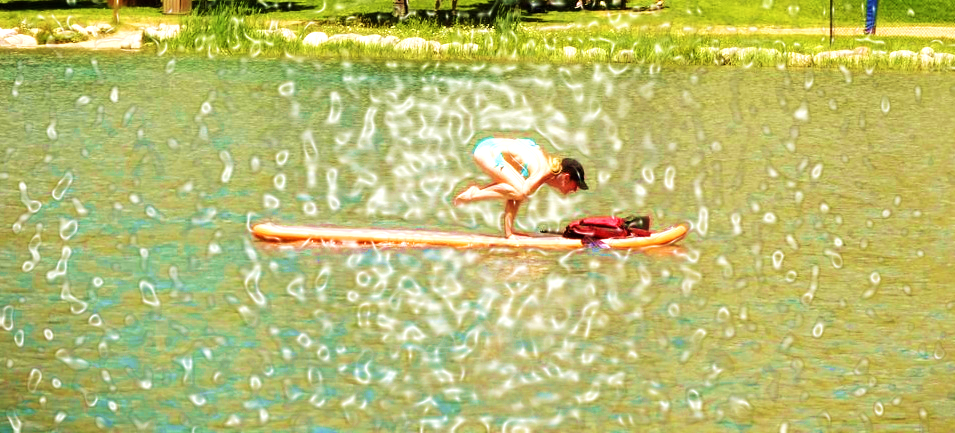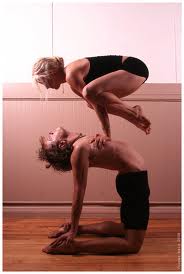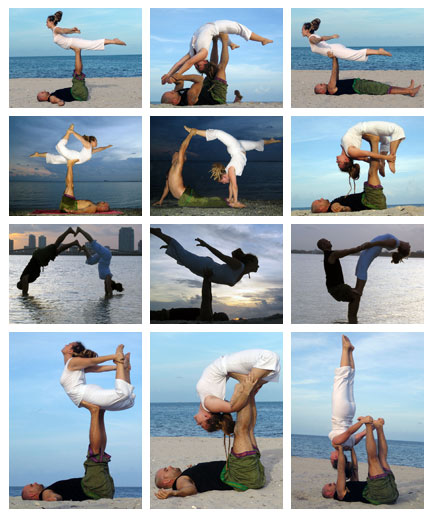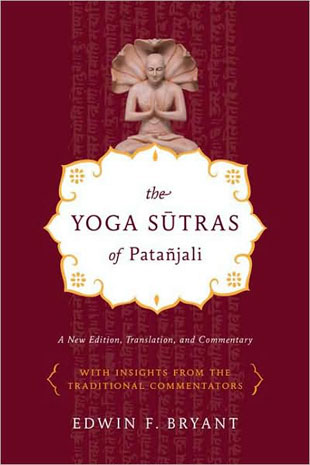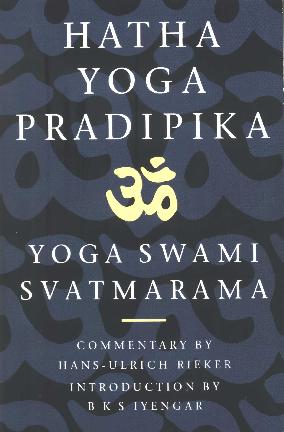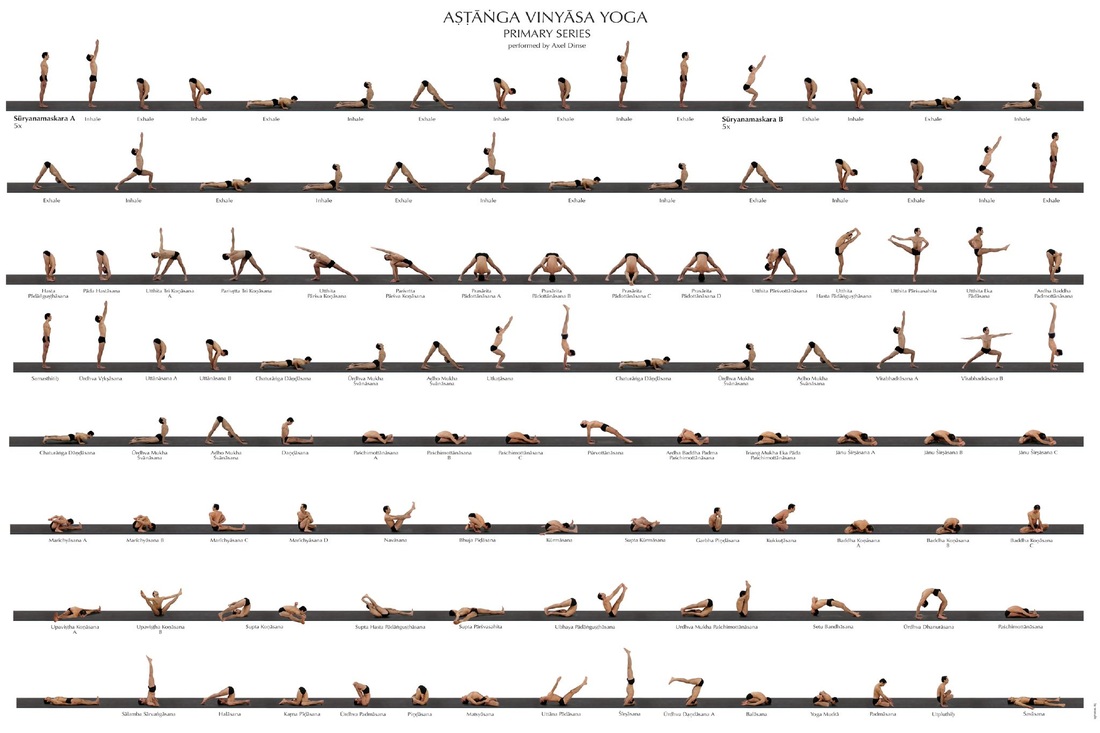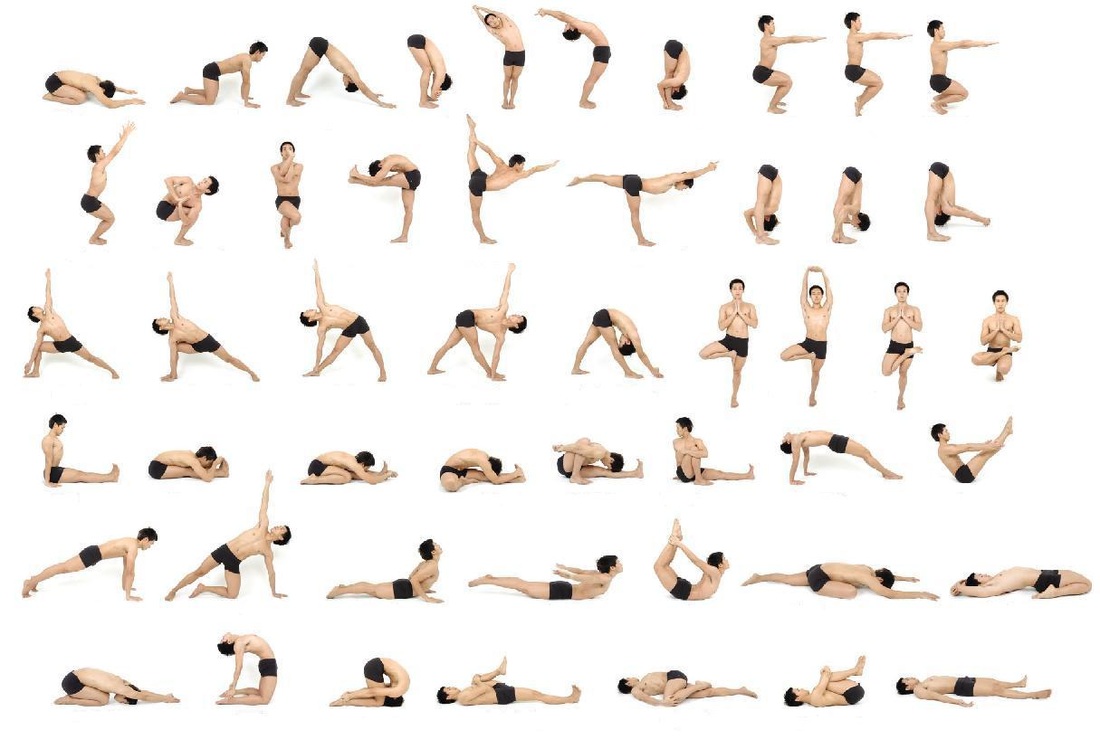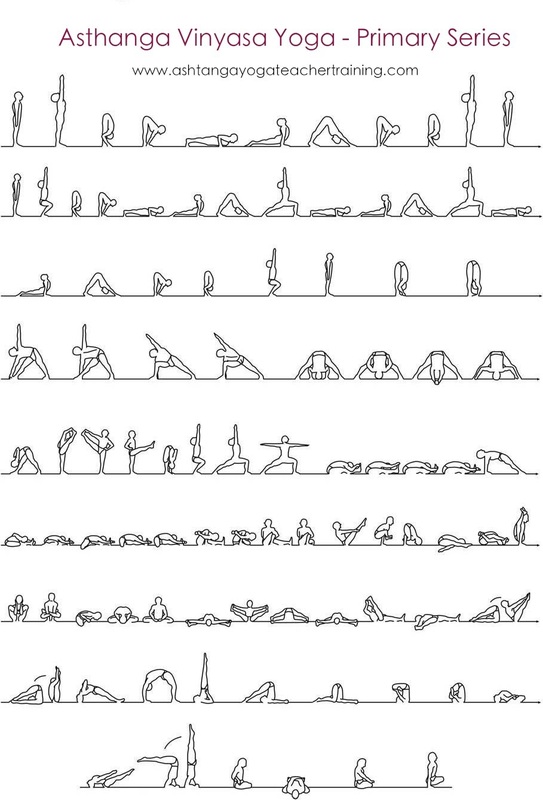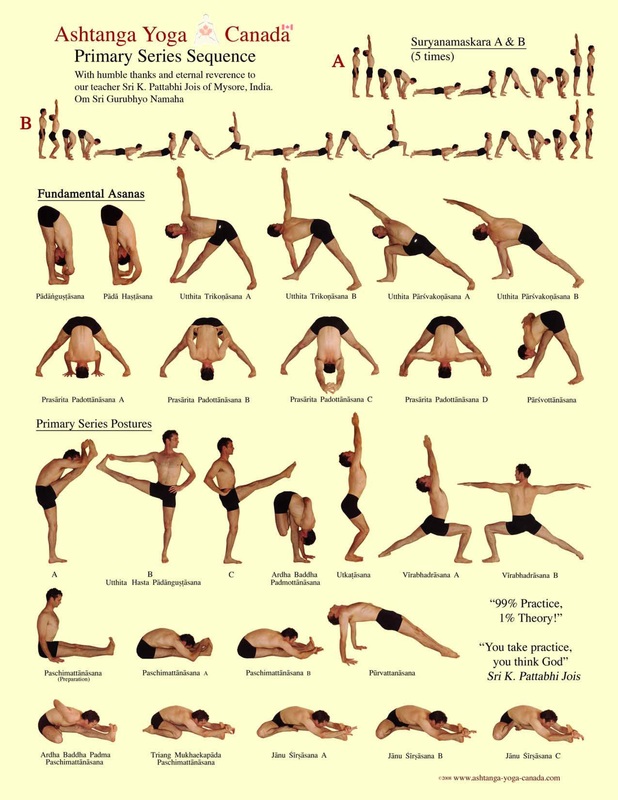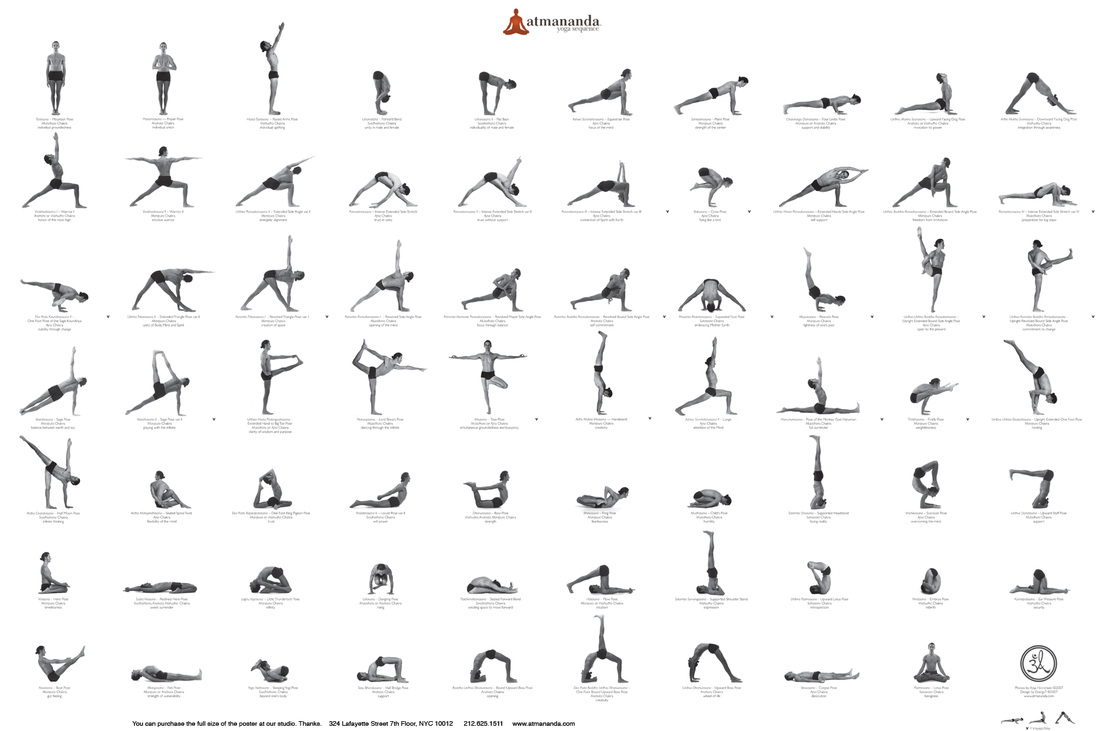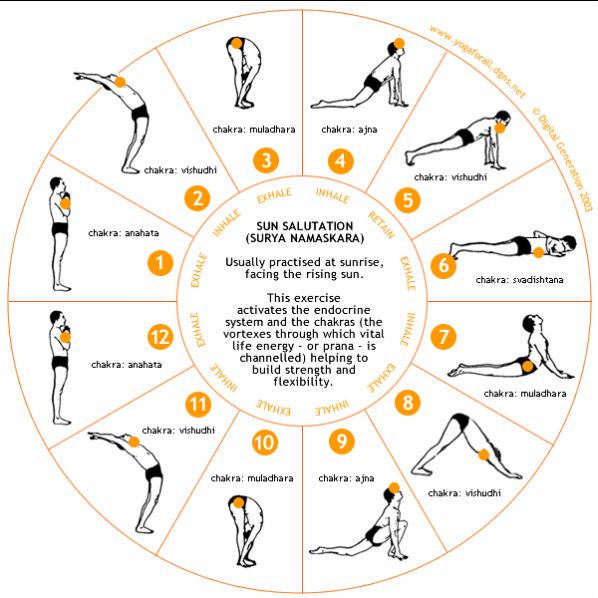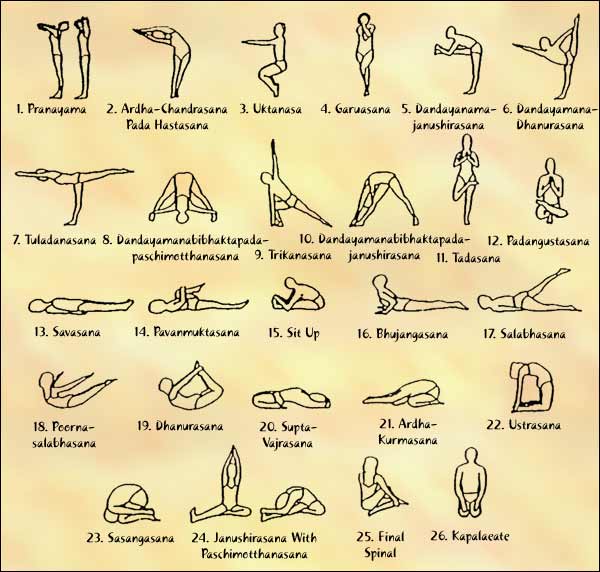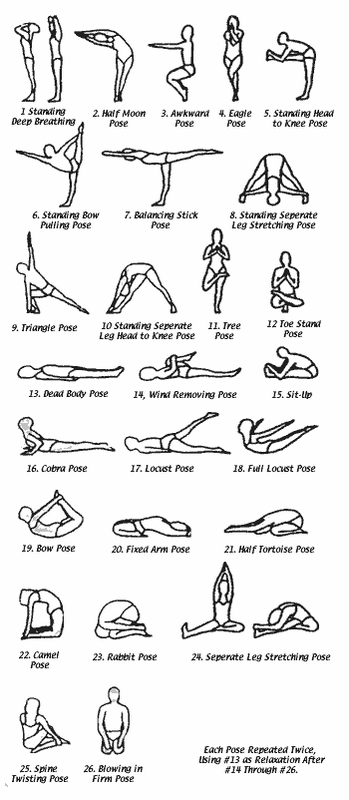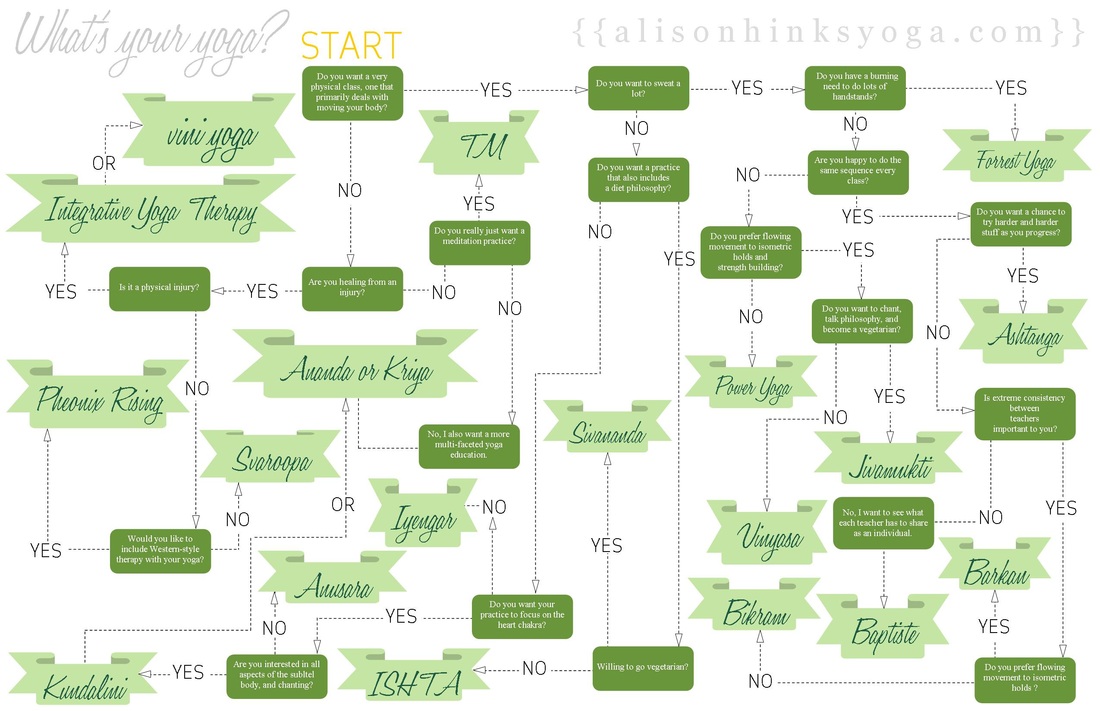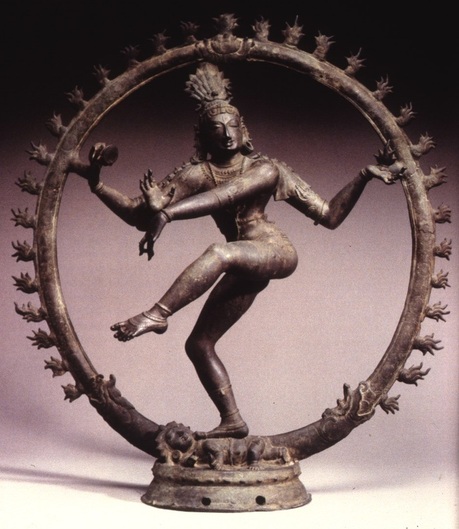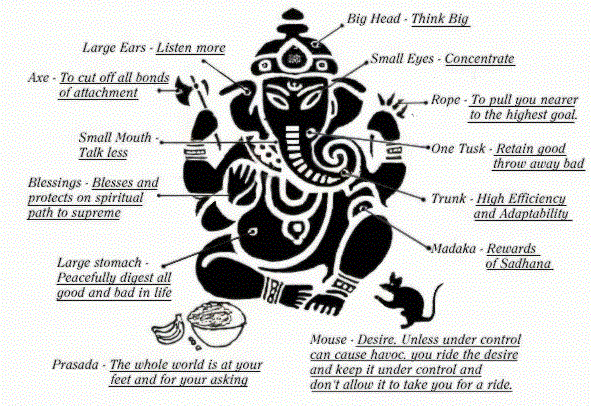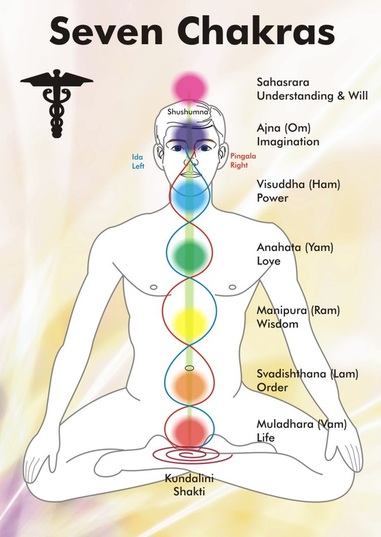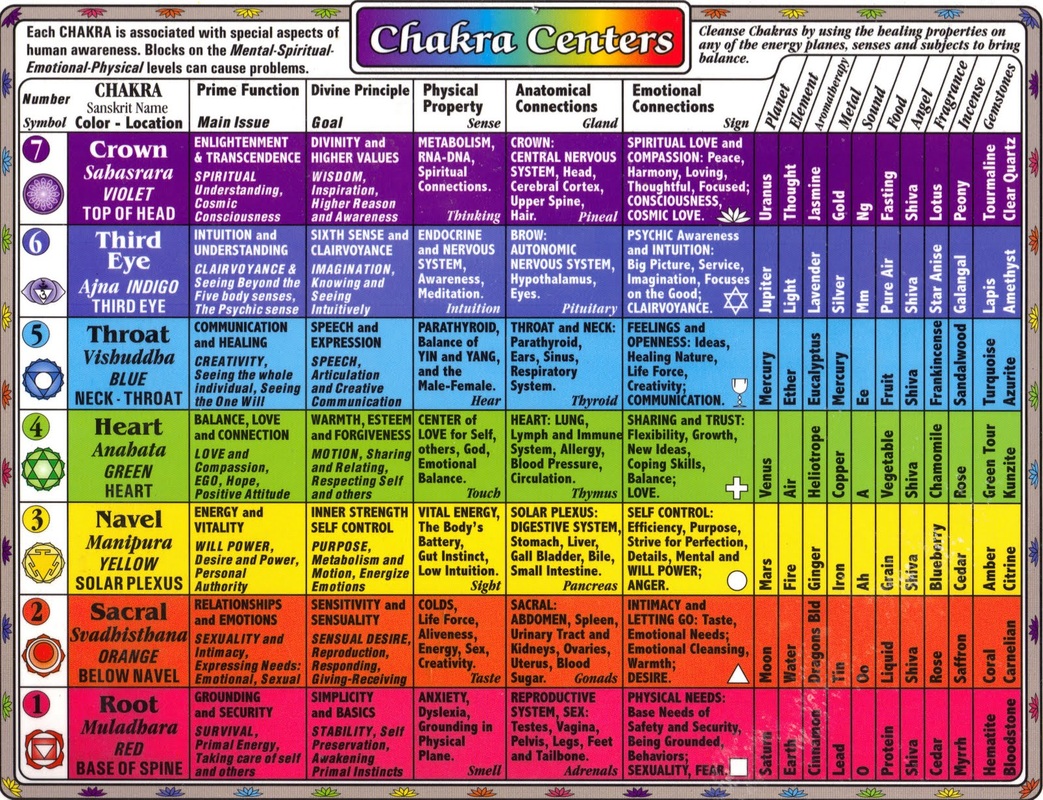|
~Namaste~
“The light within me bows to the light within you….Beyond [ourselves] lurks a dimension that is more than the body, the persona, the ego….a dimension where there isn't a 'you' and 'me' but rather a synergy that is more…. a space for the eternal to rest within the temporal.” |
~Lokah Samastah Sukhino Bhavantu~
"May all beings everywhere be happy and free, and may the thoughts, words, and actions of my own life contribute in some way to that happiness and to that freedom for all." More: http://www.jivamuktiyoga.com/focus/focus.jsp?viewFocusID=125/ |
Yoga and SUPing
AcroYoga
Also, check out this amazing video of Acroyoga: http://www.youtube.com/watch?v=Ou7iEXckF5k
Jivamukti Yoga
Jivamukti Open classes center on a theme based on a globally-set "focus of the month" essay, usually written by Sharon Gannon. The theme is explored through "dharma talks."
http://www.jivamuktiyoga.com/focus/focus.jsp
http://www.jivamuktiyoga.com/focus/archives.jsp
Jivamukti Open classes center on a theme based on a globally-set "focus of the month" essay, usually written by Sharon Gannon. The theme is explored through "dharma talks."
http://www.jivamuktiyoga.com/focus/focus.jsp
http://www.jivamuktiyoga.com/focus/archives.jsp
Shastra
Shastra, or scripture, refers to the study and exploration of the four central texts of yoga as well as to the study of the Sanskrit language in which they were first written. The four texts are the Yoga Sutras of Patanjali, the Hatha Yoga Pradipika, the Bhagavad Gita, and the Upanishads.
Shastra, or scripture, refers to the study and exploration of the four central texts of yoga as well as to the study of the Sanskrit language in which they were first written. The four texts are the Yoga Sutras of Patanjali, the Hatha Yoga Pradipika, the Bhagavad Gita, and the Upanishads.
Ashtanga Vinyasa Yoga
From http://dailycupofyoga.com/2008/11/09/ashtanga-yoga-primary-series-poster/
Ashtanga yoga literally means “8 limbs yoga. ” These limbs are defined in the the second chapter of the Yoga Sutras of Patanjali.
The following are the 8 practices or limbs:
1. yama (moral restraints) – how we relate to others
2. niyama (observances) – how we relate to ourselves
3. āsana (posture) – how we relate to our body
4. prāṇāyāma (breath extension) – how we relate to our breath or spirit
5. pratyāhāra (sensory withdrawal) – how we relate to our sense organs
6. dhāraṇā (concentration) – how we relate to our mind
7. dhyāna (meditation) – moving beyond the mind
8. samādhi (meditative absorption) – deep realization and inner union
Ashtanga yoga literally means “8 limbs yoga. ” These limbs are defined in the the second chapter of the Yoga Sutras of Patanjali.
The following are the 8 practices or limbs:
1. yama (moral restraints) – how we relate to others
2. niyama (observances) – how we relate to ourselves
3. āsana (posture) – how we relate to our body
4. prāṇāyāma (breath extension) – how we relate to our breath or spirit
5. pratyāhāra (sensory withdrawal) – how we relate to our sense organs
6. dhāraṇā (concentration) – how we relate to our mind
7. dhyāna (meditation) – moving beyond the mind
8. samādhi (meditative absorption) – deep realization and inner union
From http://heartoffloridayoga.com/yoga%20poses.htm
From http://www.ashtangamysore.net/Asthanga-Vinyasa-Yoga-Teacher-Training/the-ashtanga-yoga-primary-series
From http://www.ashtanga-yoga-canada.com/ashtanga-yoga-postures.html
From http://www.devildroid.com/2012/01/07/industrialyoga-yoga-pose-diagram/
Sun Salutations
From http://folks.co.in/blog/2009/10/10/surya-namaskar-a-great-exercise-routine/
Bikram Yoga
From http://www.365toawesome.com/tag/26-yoga-poses/
Meditation and Shiva as “Lord of the Dance” (the Nata (Dance)-raja (Lord) in Sanskrit)
Shiva is a Hindu god and is traditionally thought of as a “yogi who has notice of everything that happens in the world.” Some people think of Shiva as half of a woman, but she is all woman to me. I, personally, think she rocks. Here are a few reasons why:
- This one little statue represents Creation, Preservation and Destruction (a metaphor for life, in general)
- Her movement creates the vision of a cyclical turning- much like the earth turns or rotates and similar to how existence is a recurring process of life and death.
- In her upper right hand, she holds the damaru (the little hand drum from which comes the rhythmical, “primordial, vibrating sound of creation”).
- MY FAVORITE: with her lower right hand, she makes the gesture of abhaya (removing fear, protecting, and preserving). This gives us courage to try things in life and to not have fear!
- In her upper left hand she holds agni (the “consuming fire of dynamic destruction”). Is all destruction bad? Perhaps not…discuss amongst yourself in meditation….
- With her right foot, she tramples a demon- apasmara purusha (“the ignoble personification of illusion who leads humankind astray”)- that pesky, siren song of illusion- duoh!
- Shiva raises her left leg, and, in a gesture known as the gaja hasta, “provides refuge for the troubled soul.”
- Encircling Shiva is a halo of flames (prabhamandala or “surrounding effulgence”), symbolizing the “boundaries of the cosmos.”
- “[The statue imparts] the lesson that through belief, the soul can be transported from the bondage of illusion and ignorance to salvation and eternal serenity”- hmmmmm- a metaphor for meditation perhaps???
Shiva is a Hindu god and is traditionally thought of as a “yogi who has notice of everything that happens in the world.” Some people think of Shiva as half of a woman, but she is all woman to me. I, personally, think she rocks. Here are a few reasons why:
- This one little statue represents Creation, Preservation and Destruction (a metaphor for life, in general)
- Her movement creates the vision of a cyclical turning- much like the earth turns or rotates and similar to how existence is a recurring process of life and death.
- In her upper right hand, she holds the damaru (the little hand drum from which comes the rhythmical, “primordial, vibrating sound of creation”).
- MY FAVORITE: with her lower right hand, she makes the gesture of abhaya (removing fear, protecting, and preserving). This gives us courage to try things in life and to not have fear!
- In her upper left hand she holds agni (the “consuming fire of dynamic destruction”). Is all destruction bad? Perhaps not…discuss amongst yourself in meditation….
- With her right foot, she tramples a demon- apasmara purusha (“the ignoble personification of illusion who leads humankind astray”)- that pesky, siren song of illusion- duoh!
- Shiva raises her left leg, and, in a gesture known as the gaja hasta, “provides refuge for the troubled soul.”
- Encircling Shiva is a halo of flames (prabhamandala or “surrounding effulgence”), symbolizing the “boundaries of the cosmos.”
- “[The statue imparts] the lesson that through belief, the soul can be transported from the bondage of illusion and ignorance to salvation and eternal serenity”- hmmmmm- a metaphor for meditation perhaps???
Chakras
Centers in the body to collect life energy, prana, or shakti. Ideally, you want them to be balanced, but sometimes there are blocks and other chakras must overcompensate.
This is an AMAZING website to test your chakras and it also includes ways to open your chakras, highly recommended!!
http://www.eclecticenergies.com/chakras/chakratest.php
Chart below is from http://chraeloos.wordpress.com/2012/06/24/chakrareiki-healing/
This is an AMAZING website to test your chakras and it also includes ways to open your chakras, highly recommended!!
http://www.eclecticenergies.com/chakras/chakratest.php
Chart below is from http://chraeloos.wordpress.com/2012/06/24/chakrareiki-healing/
Chart below is from http://projectinnerpeace.org/what-is-a-chakra/
Why Every Athlete Should Do Yoga
By Rich Roll
from http://www.mindbodygreen.com/0-4806/Why-Every-Athlete-Should-Do-Yoga.html
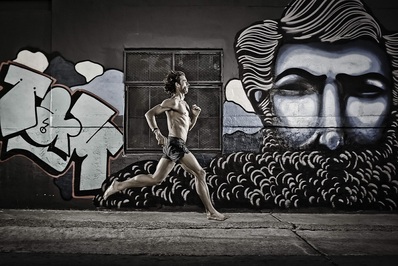
Just the other day I was having dinner with an old swimming buddy of mine, Mark Henderson, a former world record holder and Olympic Gold Medalist in the 4x100 Medley Relay at the Atlanta Games. In other words, a phenomenal athlete.
Sure, we talked about swimming. Then our conversation turned (quite unexpectedly) to yoga. Mark had begun practicing recently and was amazed by the results – increased strength, presence of mind and improved sleep, to name a few. The list goes on. Almost simultaneously, we spurted out the same lament: “Why didn’t we do this when we were competing!?” In truth, I wish I had discovered yoga during my prime swimming years back in the 1980’s. Because there is no doubt in my mind that it would have made me a much better athlete, not to mention human being. Thankfully, I discovered it many years later. And it has improved my life in amazing and unpredictable ways – not just with respect to my career as a middle-aged ultra-distance triathlete, but in countless areas of my life. In my opinion, EVERY athlete – irrespective of sport or discipline – has the potential to enhance his or her ability by adopting a consistent yoga practice. I’d go so far as to say that if you’re not practicing yoga, you’re competing at a disadvantage and missing an opportunity to enhance peak performance. Here are a few benefits I have reaped:
1. Improved Strength: Routine and consistent practice of the various yoga asanas (poses or postures) has helped me build strength and improve lean muscle mass. Most notably with respect to several muscle groups under-utilized in my chosen athletic disciplines of swimming, cycling and running. These gains have enhanced core body stability and significantly impeded overuse injury by strengthening the supportive but otherwise under-developed muscles surrounding the more utilized muscles, creating a more balanced and optimally functional overall strength.
2. Balance: As a swimmer, I have always been rather flexible. But my balance is historically horrible. But through a consistent yoga practice, my coordination and balance have improved immensely. Why is this important? Better balance and coordination means enhanced control over how I move my body, which in turn leads to better technique and form -- the brass ring every athlete spends a career refining, whether your focus is a swim stroke, golf swing, running stride, jump shot or wrestling move.
3. Flexibility: Yoga invariably improves joint and muscular flexibility, which is crucial to the body’s overall structural soundness. Enhanced joint and muscle pliancy translates to greater range of motion, or an increase in the performance latitude for a particular movement or series of movements. For example, a swimmer with supple shoulder and hip joints is able to capture and pull more water than a swimmer with a more limited range of motion. The result is more forward movement per stroke as well as enhanced muscular economy. In turn, this increased range of motion provides a greater ability to strength condition a particular muscle group due to the amelioration in overall force that can be exerted with each movement. And although there is some dispute about the advisability of “over” stretching (for runners in particular), I remain a huge advocate, finding that the more I work to maintain my flexibility (something that wanes with age), the less likely I am to suffer an overuse injury.
4. Mental Control: The physical benefits of yoga for the athlete are huge. But they’re nothing in comparison to the more ephemeral benefits. Most people, particularly athletes, tend to think of yoga as a great “workout” – a means to tighten the core, flatten the stomach and tone that butt. Sure, it does that. But as soon as the rigorous portion of the class comes to a close and it’s time for savasana (corpse pose), otherwise known as the meditative portion of the session where the student lies down on his or her back for a period of quiet meditation, I watch people flee for the door, ducking out early under the false belief that this most important asana is optional and unnecessary – the hard work is done. Not only are these people wrong, they’re missing the point of yoga entirely. Because savasana is where the magic happens. Deprive yourself of this experience and you are missing out on the best and most beneficial part of the practice. From a traditionalist point of view, the series of physically challenging yoga asanas were originally designed for a specific purpose that has nothing to do with the strength or flexibility. Instead, they were conceived and organized solely as a means to prepare the mind and body to reap maximum benefit from the important meditation that follows, which, taken as a whole, is a routine designed not to give you a nice butt, but to improve your ability to quell, quiet and control the impulses of the mind -- to clean mental house, center focus and promote serenity by silencing the endless and seemingly unmanageable mental chatter that invades our daily experience and undermines the expression of our “best self” within. In other words, savasana is the most important part of the practice for the athlete (and everyone). Why? Because the mind is a mysterious contraption, more often than not an actual enemy, constantly impulsing us with negative and fear-based signals that keep us trapped, afraid and all too often paralyzed to unlock the dormant and untapped potential within that is yearning to come out. What does this have to do with athletic performance? Everything. When you look at the highest levels of sport, all the athletes are incredibly talented. They all train equally hard. So what distinguishes the Olympic champion from the also-ran? The mind. The guy or girl who wins typically knows he/she is going to win. Unrestrained by fear, free from negative thought patterns, and laser focused, I think it’s fair to submit that the champion athlete most likely has enhanced dominion over his/her thoughts when compared to his/her competitors, able to leverage it’s incredible power to focus entirely on the task at hand and remain thoroughly rooted in the present moment without the invasion of unhelpful thought patterns. They visualize success so completely that it literally becomes a foregone conclusion. Much like a muscle, the mind can be trained. And consistent practice of the asanas when followed up with proper savasana is the best way I have found to not only improve my sleep, reduce stress, quell negative mental chatter, and manage (and walk through) fear, it informs my entire approach to training and racing. And has made all the difference in helping me achieve some rather fantastical athletic goals that seemed not only far beyond my capabilities, but almost impossible from any objective or logical perspective.
5. I Met My Wife In Yoga: The biggest benefit I have reaped from yoga? 14 years ago I met my wife in a yoga class. We’ve been together ever since. Not only is she a fantastic yoga teacher, she has been instrumental in making me a better man and a better athlete. So there you go. Don’t underestimate the extent to which yoga can change your life -- you just never know. Looking for an athletic edge? This is it. So get on it, before your rival does.
Sure, we talked about swimming. Then our conversation turned (quite unexpectedly) to yoga. Mark had begun practicing recently and was amazed by the results – increased strength, presence of mind and improved sleep, to name a few. The list goes on. Almost simultaneously, we spurted out the same lament: “Why didn’t we do this when we were competing!?” In truth, I wish I had discovered yoga during my prime swimming years back in the 1980’s. Because there is no doubt in my mind that it would have made me a much better athlete, not to mention human being. Thankfully, I discovered it many years later. And it has improved my life in amazing and unpredictable ways – not just with respect to my career as a middle-aged ultra-distance triathlete, but in countless areas of my life. In my opinion, EVERY athlete – irrespective of sport or discipline – has the potential to enhance his or her ability by adopting a consistent yoga practice. I’d go so far as to say that if you’re not practicing yoga, you’re competing at a disadvantage and missing an opportunity to enhance peak performance. Here are a few benefits I have reaped:
1. Improved Strength: Routine and consistent practice of the various yoga asanas (poses or postures) has helped me build strength and improve lean muscle mass. Most notably with respect to several muscle groups under-utilized in my chosen athletic disciplines of swimming, cycling and running. These gains have enhanced core body stability and significantly impeded overuse injury by strengthening the supportive but otherwise under-developed muscles surrounding the more utilized muscles, creating a more balanced and optimally functional overall strength.
2. Balance: As a swimmer, I have always been rather flexible. But my balance is historically horrible. But through a consistent yoga practice, my coordination and balance have improved immensely. Why is this important? Better balance and coordination means enhanced control over how I move my body, which in turn leads to better technique and form -- the brass ring every athlete spends a career refining, whether your focus is a swim stroke, golf swing, running stride, jump shot or wrestling move.
3. Flexibility: Yoga invariably improves joint and muscular flexibility, which is crucial to the body’s overall structural soundness. Enhanced joint and muscle pliancy translates to greater range of motion, or an increase in the performance latitude for a particular movement or series of movements. For example, a swimmer with supple shoulder and hip joints is able to capture and pull more water than a swimmer with a more limited range of motion. The result is more forward movement per stroke as well as enhanced muscular economy. In turn, this increased range of motion provides a greater ability to strength condition a particular muscle group due to the amelioration in overall force that can be exerted with each movement. And although there is some dispute about the advisability of “over” stretching (for runners in particular), I remain a huge advocate, finding that the more I work to maintain my flexibility (something that wanes with age), the less likely I am to suffer an overuse injury.
4. Mental Control: The physical benefits of yoga for the athlete are huge. But they’re nothing in comparison to the more ephemeral benefits. Most people, particularly athletes, tend to think of yoga as a great “workout” – a means to tighten the core, flatten the stomach and tone that butt. Sure, it does that. But as soon as the rigorous portion of the class comes to a close and it’s time for savasana (corpse pose), otherwise known as the meditative portion of the session where the student lies down on his or her back for a period of quiet meditation, I watch people flee for the door, ducking out early under the false belief that this most important asana is optional and unnecessary – the hard work is done. Not only are these people wrong, they’re missing the point of yoga entirely. Because savasana is where the magic happens. Deprive yourself of this experience and you are missing out on the best and most beneficial part of the practice. From a traditionalist point of view, the series of physically challenging yoga asanas were originally designed for a specific purpose that has nothing to do with the strength or flexibility. Instead, they were conceived and organized solely as a means to prepare the mind and body to reap maximum benefit from the important meditation that follows, which, taken as a whole, is a routine designed not to give you a nice butt, but to improve your ability to quell, quiet and control the impulses of the mind -- to clean mental house, center focus and promote serenity by silencing the endless and seemingly unmanageable mental chatter that invades our daily experience and undermines the expression of our “best self” within. In other words, savasana is the most important part of the practice for the athlete (and everyone). Why? Because the mind is a mysterious contraption, more often than not an actual enemy, constantly impulsing us with negative and fear-based signals that keep us trapped, afraid and all too often paralyzed to unlock the dormant and untapped potential within that is yearning to come out. What does this have to do with athletic performance? Everything. When you look at the highest levels of sport, all the athletes are incredibly talented. They all train equally hard. So what distinguishes the Olympic champion from the also-ran? The mind. The guy or girl who wins typically knows he/she is going to win. Unrestrained by fear, free from negative thought patterns, and laser focused, I think it’s fair to submit that the champion athlete most likely has enhanced dominion over his/her thoughts when compared to his/her competitors, able to leverage it’s incredible power to focus entirely on the task at hand and remain thoroughly rooted in the present moment without the invasion of unhelpful thought patterns. They visualize success so completely that it literally becomes a foregone conclusion. Much like a muscle, the mind can be trained. And consistent practice of the asanas when followed up with proper savasana is the best way I have found to not only improve my sleep, reduce stress, quell negative mental chatter, and manage (and walk through) fear, it informs my entire approach to training and racing. And has made all the difference in helping me achieve some rather fantastical athletic goals that seemed not only far beyond my capabilities, but almost impossible from any objective or logical perspective.
5. I Met My Wife In Yoga: The biggest benefit I have reaped from yoga? 14 years ago I met my wife in a yoga class. We’ve been together ever since. Not only is she a fantastic yoga teacher, she has been instrumental in making me a better man and a better athlete. So there you go. Don’t underestimate the extent to which yoga can change your life -- you just never know. Looking for an athletic edge? This is it. So get on it, before your rival does.
Laird Hamilton Says: Turn Your Workout Upside Down
from http://archive.mensjournal.com/laird-hamiltons-says-turn-your-workout-upside-down

With his debut column, the big-wave surfer wants you to do the opposite of everything gym rats tell you.
Between curls and crunches and squats, we're always folding in on ourselves. With his debut column, Hamilton says it's crucial to remember to open up as well.
I’ve been hanging upside down a lot lately. Nothing decompresses me more or has a better overall positive effect than that. It stretches and elongates my spine, gets blood flowing to my head, and takes pressure off my organs. Being upside down is the ultimate counter balance to the repetitive motions we do in our vertical lives — walking, standing, paddle-boarding, sitting upright. There’s a saying among yogis that a man who can stand on his head 20 minutes a day masters time. I haven’t mastered time, but I do try to put in 20 minutes a day upside down — whether I’m doing a headstand or hanging from a harness in my garage — to provide a little counterbalance to the rest of my life.
And I never would have done it if I hadn’t torn my ACL and been forced to really think about what I was doing to my body and why I needed to find a way to counteract the motions I was overdoing. I blamed the ACL injury on biking. I loved biking — I’d been riding hard a few hours every day — but the sheer volume of repetitive motion was killing me. It built up certain muscles — quads, hip flexors — while ignoring others, which was creating tightness in my lower back and IT band, and I wasn’t doing a thing to counteract it. So I started riding backward.
At first, it was just a hunch, an unformed theory. I did it mainly because I hoped it would help me avoid injury. But then I started to see and feel the results, and that’s where the revelation came in. When I went back to pedaling normally — that is, frontward — I discovered that I had a better relationship with my stroke. Not only did going backward counteract the repetitive motion that was causing my problems, it also improved my dexterity and coordination. It made my normal stroke feel more fluid and instinctive.
I later found out that backward pedaling is something world-class cyclists have been doing for years. I also discovered that Bruce Lee’s method of punching faster was actually to try to recoil quicker. It’s kind of counterintuitive — you think you’d be faster by speeding up the extension, but really your speed comes through the recoil. Normally you’re thinking only about punching, so somewhere there’s a shutoff in your consciousness, and you’re not thinking about pulling back. But when you incorporate the muscles that it takes to pull back and initiate them into moving forward, you find the gain. It’s like the muscles become more educated. We always say, “Train smarter, not harder,” and ultimately, it’s about enhancing performance. The irony is that what enhances performance also helps prevent injuries.
Once you start being conscious of the repetitive motions that we all just accept as part of being human, you realize how little we do to counteract those motions. Instead we usually go out of our way to do more of them. Think of working out in the gym. All the movements are about folding inward. Between curls and crunches and squats, we’re always tightening and closing ourselves up. It’s crucial to remember to open up as well — whether it’s on a cable machine or with a weight, incorporate more movements where you’re extending and opening yourself up. Coincidentally, they’re harder to do and you don’t need as much weight to do them. It’s all an opposite reaction to how we normally do things.
Usually, working out is about aesthetics — six-pack abs and biceps and pecs — instead of true functionality. True function has a different aesthetic appeal. Of course, any kind of working out is better than no kind of working out. Everybody gets an endorphin high from it: You sweat, you eat good, you sleep better, sex is better — it’s life- enhancing. All of this is positive stuff, but there are repercussions over time, and you risk blowing something out and just getting stiffer and stiffer over time.
You could still have all that — you could be ripped up and have all the guns and do all the deal and have all the power, but you’re going to have to combat all that tightness with something. And if you do, your posture will be more open and you’ll be better balanced. You may not look like you would if you did 500 sit-ups a day, but you’ll perform better, and for me, training was always about enhancing performance. At the end of the day, it’s really about running faster, jumping higher, hitting the ball better, and functioning better, so you can run and swim and do all these things you want to do. That’s life.
— This article originally appeared in the February 2012 issue of Men’s Journal. Photograph by Ture Lillegraven
Between curls and crunches and squats, we're always folding in on ourselves. With his debut column, Hamilton says it's crucial to remember to open up as well.
I’ve been hanging upside down a lot lately. Nothing decompresses me more or has a better overall positive effect than that. It stretches and elongates my spine, gets blood flowing to my head, and takes pressure off my organs. Being upside down is the ultimate counter balance to the repetitive motions we do in our vertical lives — walking, standing, paddle-boarding, sitting upright. There’s a saying among yogis that a man who can stand on his head 20 minutes a day masters time. I haven’t mastered time, but I do try to put in 20 minutes a day upside down — whether I’m doing a headstand or hanging from a harness in my garage — to provide a little counterbalance to the rest of my life.
And I never would have done it if I hadn’t torn my ACL and been forced to really think about what I was doing to my body and why I needed to find a way to counteract the motions I was overdoing. I blamed the ACL injury on biking. I loved biking — I’d been riding hard a few hours every day — but the sheer volume of repetitive motion was killing me. It built up certain muscles — quads, hip flexors — while ignoring others, which was creating tightness in my lower back and IT band, and I wasn’t doing a thing to counteract it. So I started riding backward.
At first, it was just a hunch, an unformed theory. I did it mainly because I hoped it would help me avoid injury. But then I started to see and feel the results, and that’s where the revelation came in. When I went back to pedaling normally — that is, frontward — I discovered that I had a better relationship with my stroke. Not only did going backward counteract the repetitive motion that was causing my problems, it also improved my dexterity and coordination. It made my normal stroke feel more fluid and instinctive.
I later found out that backward pedaling is something world-class cyclists have been doing for years. I also discovered that Bruce Lee’s method of punching faster was actually to try to recoil quicker. It’s kind of counterintuitive — you think you’d be faster by speeding up the extension, but really your speed comes through the recoil. Normally you’re thinking only about punching, so somewhere there’s a shutoff in your consciousness, and you’re not thinking about pulling back. But when you incorporate the muscles that it takes to pull back and initiate them into moving forward, you find the gain. It’s like the muscles become more educated. We always say, “Train smarter, not harder,” and ultimately, it’s about enhancing performance. The irony is that what enhances performance also helps prevent injuries.
Once you start being conscious of the repetitive motions that we all just accept as part of being human, you realize how little we do to counteract those motions. Instead we usually go out of our way to do more of them. Think of working out in the gym. All the movements are about folding inward. Between curls and crunches and squats, we’re always tightening and closing ourselves up. It’s crucial to remember to open up as well — whether it’s on a cable machine or with a weight, incorporate more movements where you’re extending and opening yourself up. Coincidentally, they’re harder to do and you don’t need as much weight to do them. It’s all an opposite reaction to how we normally do things.
Usually, working out is about aesthetics — six-pack abs and biceps and pecs — instead of true functionality. True function has a different aesthetic appeal. Of course, any kind of working out is better than no kind of working out. Everybody gets an endorphin high from it: You sweat, you eat good, you sleep better, sex is better — it’s life- enhancing. All of this is positive stuff, but there are repercussions over time, and you risk blowing something out and just getting stiffer and stiffer over time.
You could still have all that — you could be ripped up and have all the guns and do all the deal and have all the power, but you’re going to have to combat all that tightness with something. And if you do, your posture will be more open and you’ll be better balanced. You may not look like you would if you did 500 sit-ups a day, but you’ll perform better, and for me, training was always about enhancing performance. At the end of the day, it’s really about running faster, jumping higher, hitting the ball better, and functioning better, so you can run and swim and do all these things you want to do. That’s life.
— This article originally appeared in the February 2012 issue of Men’s Journal. Photograph by Ture Lillegraven
